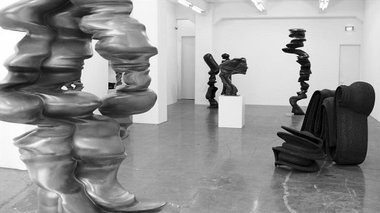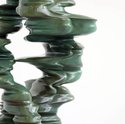John Hurrell – 20 December, 2011
Hard metal here looks fluid and oozy, alluding to layered and viscous geological processes, whilst also being dreamlike in its references to female faces and distorted torsos. Rock turns into flesh, buttes become butts, and warm zephyrs of desire blow now where freezing desert gales used to rage.
For many people exploring the new version of Auckland Art Gallery, especially those looking at the contemporary art on the top floor, one of the most exhilarating surprises is to discover Tony Cragg’s Clear Glass Stack (1999) amongst the overseas collection. This fragile sculpture with its squat tower of interlocking platforms and wide range of delicate bluish glassware, thrills with its piercing reflected and radiating light and dense transparent surfaces.
Cragg of course is well known in this country ever since his work came to the National Gallery in Wellington in the mid-eighties as part of The British Show organised by AGNSW, and curated by Tony Bond and William Wright. He since then has had one person shows at Shed 11, City Gallery and Gow Langsford, and is one of those brilliant artists with a knack of changing our thinking about art materials and their connotations as symbolic substances - how they affect the specifics of representation. The eighties was a stunning time for British sculpture and Cragg was (in my view) the most inventive out of about a dozen similarly inspired UK artists.
In the nineties his work shifted from being arte provera influenced (using found palings of wood, rocks, or beachcombed plastic) to using more traditional sculptural materials. The bronze and steel works that dominate this current Gow Langsford show seem a carry-over from the stratified sandstone figures he sometimes used to make, but now replacing Moore with Dali to investigate negative space and contour - in relation to the moving viewer.
Hard metal (and on one occasion marble) here looks fluid and oozy, alluding to layered and viscous geological processes, whilst also being dreamlike in its references to female faces and distorted torsos. Rock turns into flesh, buttes become butts, and warm zephyrs of desire blow now where freezing desert gales used to rage.
Serene women’s faces and oddly doubled limbs tilt, blur and twist as you wander around these erotic buckling columns that look initially like teetering stacks of clay pancakes. They seem to be teasing evanescent spirits (out of Greek mythology) visible from a distance but which disappear as you approach, flat alluring silhouettes dissolving into more complicated volumetric forms close up.
There is another sort of sculptural form in the show, quite unlike the dominant vertical ‘stacks’. Digital Skin is the only item here with no reference to the human form. It is a horizontally poured, bent or rolling strip, a tyre retread shape, which despite its industrial textures and patterns is more akin to say, the sludgy and faecal flow of the plastic extrusions in the recent sculpture of Julia Morison, than the rest of this stratified and elegant exhibition.
Cragg is always a wondrously innovative experimenter with his restlessly evocative forms, revitalised materials and complex texture. As with many sculptors these days, digital drawing processes seem to have helped him convert invented structures into dynamic three-dimensional form. Terrific work.
John Hurrell









 Two Rooms presents a program of residencies and projects
Two Rooms presents a program of residencies and projects Advertising in this column
Advertising in this column



This Discussion has 0 comments.
Comment
Participate
Register to Participate.
Sign in
Sign in to an existing account.